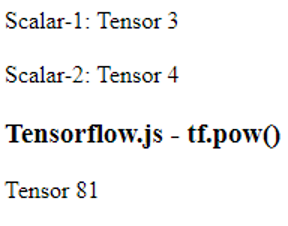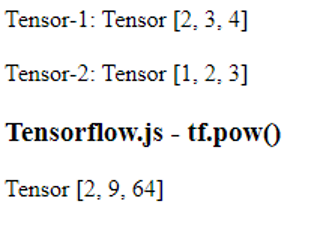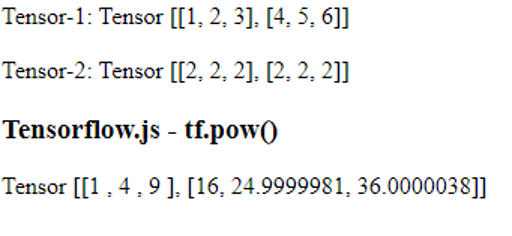Tensorflow.js – tf.pow()
Scenario 1: Work With Scalar
Scalar will store only one value. But anyway, it returns a tensor.
Syntax
Parameters
scalar1 and scalar2 are the tensors that can take only one value as a parameter.
Return
Return remainder of two scalar values.
Example
Create two scalars and raise the power to value present in the second scalar.
<!-- CDN Link that delivers the Tensorflow.js framework -->
<script src="https://cdn.jsdelivr.net/npm/@tensorflow/tfjs"></script>
<body>
<script>
//scalar1
let value1 = tf.scalar(3);
//scalar2
let value2 = tf.scalar(4);
document.write("Scalar-1: ",value1);
document.write("<br>");
document.write("<br>");
document.write("Scalar-2: ",value2);
</script>
<h3>Tensorflow.js - tf.pow() </h3>
<script>
//tf.pow(value1,value2)
document.write(tf.pow(value1,value2));
</script>
</body>
</html>
Output

Working
3 to the power of 4 => 3*3*3*3 = 81.
Scenario 2: Work With Tensor
A tensor can store multiple values; it can be single or multi-dimensional.
Syntax
Parameters
tensor1 and tensor2 are the tensors that can take only single or multiple values as a parameter.
Return
Power of values.
We must notice that the total number of elements in both the tensors must be equal.
Example 1
Create two one-dimensional tensors and return the power of elements in a first tensor concerning values in a second tensor.
<!-- CDN Link that delivers the Tensorflow.js framework -->
<script src="https://cdn.jsdelivr.net/npm/@tensorflow/tfjs"></script>
<body>
<script>
//tensor1
let values1 = tf.tensor1d([2,3,4]);
//tensor2
let values2 = tf.tensor1d([1,2,3]);
document.write("Tensor-1: ",values1);
document.write("<br>");
document.write("<br>");
document.write("Tensor-2: ",values2);
</script>
<h3>Tensorflow.js - tf.pow() </h3>
<script>
//tf.pow(values1,values2)
document.write(tf.pow(values1,values2));
</script>
</body>
</html>
Output

Working
[2 power 1,3 power 2,4 power 3,] => Tensor [2,9,64].
Example 2
Create 2 two-dimensional tensors with 2 rows and 3 columns and apply tf.pow().
<!-- CDN Link that delivers the Tensorflow.js framework -->
<script src="https://cdn.jsdelivr.net/npm/@tensorflow/tfjs"></script>
<body>
<script>
//tensor1
let values1 = tf.tensor2d([1,2,3,4,5,6],[2,3]);
//tensor2
let values2 = tf.tensor2d([2,2,2,2,2,2],[2,3]);
document.write("Tensor-1: ",values1);
document.write("<br>");
document.write("<br>");
document.write("Tensor-2: ",values2);
</script>
<h3>Tensorflow.js - tf.pow() </h3>
<script>
//tf.pow(values1,values2)
document.write(tf.pow(values1,values2));
</script>
</body>
</html>
Output

Scenario 3: Work With Tensor & Scalar
It can be possible to raise the power of each element in a tensor by a scalar.
Syntax
Example
Create a one-dimensional tensor, a scalar, and raise each element in a tensor to a scalar value.
<!-- CDN Link that delivers the Tensorflow.js framework -->
<script src="https://cdn.jsdelivr.net/npm/@tensorflow/tfjs"></script>
<body>
<script>
//tensor
let values1 = tf.tensor1d([10,20,30,4,5,6]);
//scalar
let value2 = tf.scalar(2);
document.write("Tensor: ",values1);
document.write("<br>");
document.write("<br>");
document.write("Scalar: ",value2);
</script>
<h3>Tensorflow.js - tf.pow() </h3>
<script>
//tf.pow(values1,value2)
document.write(tf.pow(values1,value2));
</script>
</body>
</html>
Output

Conclusion
tf.pow() in tensorflow.js is used to raise power with respect to the values in another tensor. Also, we noticed that scalar will store only one value and returns a tensor. While performing tf.pow() on two tensors, ensure that the number of elements in two tensors must be the same.
Source: linuxhint.com
